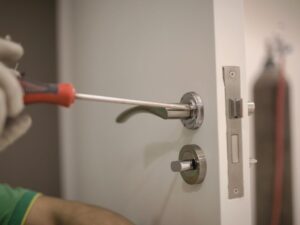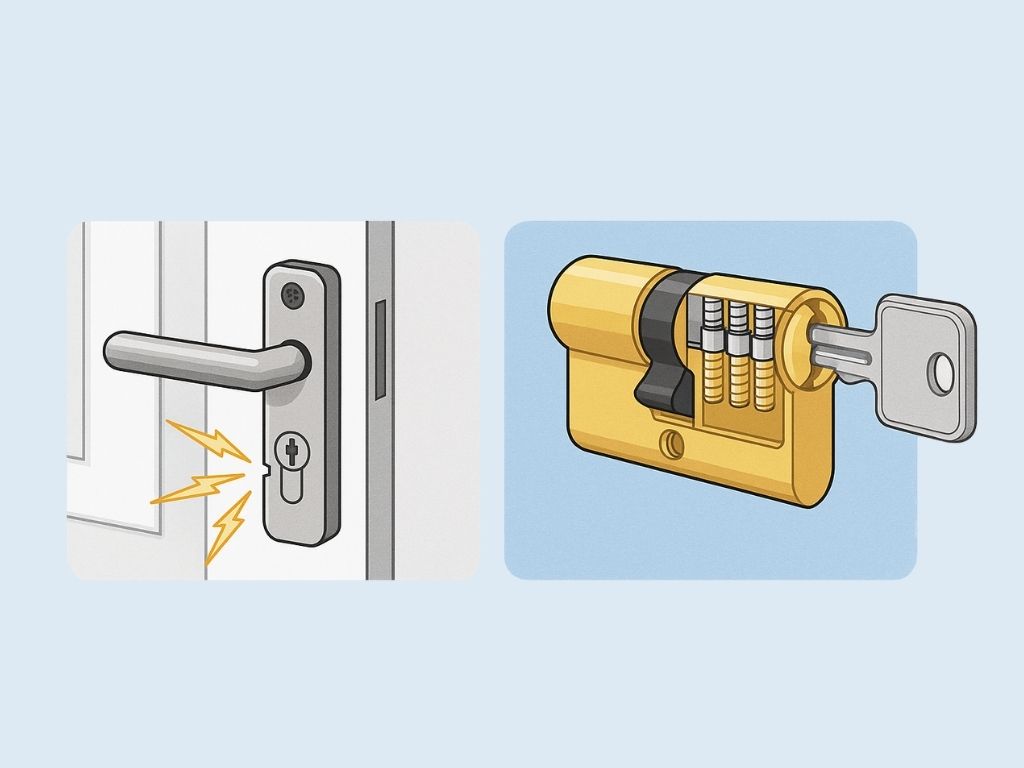
- 01708 453168
- info@atcl.co.uk
- Office Hours: Mon - Sat: 7:30 - 17:30
- 24hr Emergency Callout

If you’ve got a UPVC door at home, you might have heard terms like anti-snap or anti-bump when talking about locks. They come up often in home security conversations, but many people aren’t sure what they actually mean. And more importantly, whether they’re something you need.
As UPVC locksmiths, we get asked about this all the time. It’s a fair question. Most standard UPVC locks look the same from the outside, but there’s a big difference in how they work internally, especially when it comes to stopping break-ins.
Here’s what you should know.
Lock snapping is one of the easiest ways someone can force their way through a door with a standard euro cylinder. It doesn’t require a special tool, just pressure in the right place.
The weak point is usually the middle of the cylinder. If enough force is applied, it breaks in two. Once that happens, the rest of the mechanism can be manipulated fairly quickly.
We’ve seen this many times, usually after a call-out where someone’s had a break-in. And it’s nearly always the same type of cylinder involved.
Lock bumping is a different technique. Instead of breaking the lock, a specially cut key, called a bump key, is used to quickly force the pins inside the cylinder into the right positions.
It doesn’t take long. In fact, it’s often over before anyone notices. No sign of damage is left behind, which makes it harder to detect.
We’ve come across doors where nothing looked out of place, but once opened, it became clear a bump key had been used. For many homeowners, it comes as a complete surprise.
Some euro cylinders are built to make bumping much more difficult. These include:
These small changes help stop bumping from working. It doesn’t mean the lock is impossible to open, but it’s far less likely to be bypassed using this method.
We always explain this when we’re on-site fitting or upgrading UPVC door locks. Most people are surprised how vulnerable older locks are, especially when they’ve been in place for years.
UPVC doors are very common, and that makes them a target. Most of the ones we come across have standard euro cylinders, many of which were installed during construction or by previous tenants. They’re not always bad, just not designed to handle modern break-in techniques.
We’ve worked on a lot of these over the years and a few things often stand out:
Checking your lock doesn’t take long. And if needed, changing it is a fairly quick job. We regularly do this without replacing the whole door or frame. If the UPVC door is not closing properly that could be an entirely different issue.
If you want us to take a look, our UPVC locksmith team can help with that.
In our line of work, we don’t deal in guesswork. We’re usually called out after something has already happened. A door has been forced open. A lock has been snapped. A family feels unsettled. These are real situations we deal with every week.
We’ve also seen the other side, where a burglar has clearly tried but the lock held and the door stayed secure. That’s always a better outcome.
It’s not about selling fancy gadgets. It’s about choosing a lock that gives you a better chance. And doing it before something goes wrong.
Most people don’t give much thought to the lock on their UPVC door until something happens. The truth is, it’s often the easiest part of the door to attack, but also one of the easiest to upgrade.
A good-quality anti-snap, anti-bump cylinder doesn’t just offer better protection. It gives peace of mind, especially when you’re not home or during the night.
As locksmiths, we’ve worked on hundreds of UPVC doors across all sorts of properties. We’ve seen where corners were cut and where better locks have done their job. If there’s one part of the door not to overlook, it’s the cylinder.
EXCELLENTTrustindex verifies that the original source of the review is Google. Lovely young chap (Dan Payne) came this morning to change my elderly mother's locks. He was polite, helpful and swift. Did the job to a high standard. Will use the company again. Thank you!Posted onTrustindex verifies that the original source of the review is Google. Fantastic service! Dan came to change a lock, arrived early which I was really happy about and he was very polite on arrival. Super professional, changed the lock in no time and left no mess. Would definitely recommend 👍Posted onTrustindex verifies that the original source of the review is Google. one of the locksmiths (didn’t get the name) came and swapped out my lock today having called my council yesterday evening, they rang and I wasn’t home but they waited for me to get back. They were lovely and he was very quick so thank you.Posted onTrustindex verifies that the original source of the review is Google. Excellent service, got here in 20 minutes, had the front door open in less than 30 seconds! Thank you!Posted onTrustindex verifies that the original source of the review is Google. I have just used Around The Clock Locks (ATCL) Locksmiths and they are very professional, affordable and brilliant. They have resolved my French door lock issue within minutes and explained everything clearly. They came right on time and only start the job once we agreed the price which was very competitive. I appreciate their honesty also. I whole heartedly recommend ATCLPosted onTrustindex verifies that the original source of the review is Google. Amazing service, reasonably priced and helped me with a few other niggles I had in the property. Would highly recommendPosted onTrustindex verifies that the original source of the review is Google. Really responsive, friendly service, great work every time. Many thanksPosted onTrustindex verifies that the original source of the review is Google. I had a problem with the locks in my flat, after getting quotes from two other locksmiths, ACTL turned out to be the most responsive and reasonably priced by far. They replaced the locks (and door handle) quickly. Everything looks and works perfectly now. I also REALLY appreciated that all communication could be handled via email - no unnecessary phone calls, which was a hassle with other companies.Posted onTrustindex verifies that the original source of the review is Google. Amazing. Oliver arrived within 10 mins of my call and got my into my home quickly. He also kindly helped with a separate issue with my door. Highly recommended. Thanks so much